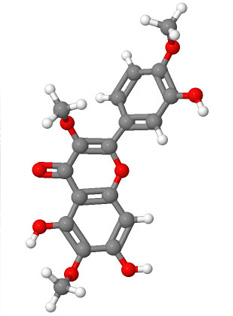







Centaureidin molecule
The first step of melanosome transfer from melanocytes to surrounding keratinocytes is successful melanocytic dendrite formation and extension towards surrounding keratinocytes. The extension of melanocytic dendrites requires the reorganization of the melanocyte cytoskeletal elements such as actin filaments and microtubules. Small GTPases Rho, Rac and Cdc42 play a pivotal role in cell morphology and dendrite formation. Specifically, Rac stimulates membrane ruffling and lamellipodia formation, Rho activates dendrite retraction and Cdc42 mediates filopodia and peripheral actin microspike formation.
Ito et al. has shown that treatment of melanocyte and keratinocyte co-cultures with methylophiopogonanone B (5,7-dihydroxy-6,8-dimethyl-3-(4-methoxybenzyl)chroman-4-one, MOPB), an agent reported to activate Rho and induce microtubule disorganization and tubule depolymerization, appeared to reduce melanosome transfer. The authors also showed that treatment with 1μM MOPB did not influence melanin synthesis or the expression of melanogenic enzymes. MOPB appeared to induce a reversible dendrite retraction and transfer inhibition without associated cytotoxicity (tested up to 72 hours).
Centaureidin (5,7,3’-trihydroxy-3,6,4’-trimethoxyflavone), a flavonoid glucoside derived from yarrow, also reduces melanosomal transfer to keratinocytes. Centaureidin is believed to directly or indirectly activate Rho, leading to melanocyte dendrite retraction without influencing melanogenic enzyme expression or melanin synthesis. More analysis is needed to confirm the applicability of MOPB and centaureidin as skin lightening agents.
>
>
>
>
>
>
>
>
>
>
>
>
>
>
>
>
>
>
>
>
>
>
>
>
>
>
>
>
>
>
>
>
>
>
>
>
>
>
>
>
>
>
>
>
>
>
>
>
>
>
>
TOP 20
Hydroquinone
Monobenzyl Ether of Hydroquinone
Azelaic Acid
Kojic Acid
Arbutin
Retinoids
Mequinol
Niacinamide
Soy
Vitamin C
Corticosteroids
Licorice
Hydroxystilbene
Aloesin
Glutathione
Glycolic Acid
N Acetyl Glucosamine
Gentisic Acid
Green Tea
Melatonin
SKIN WHITENING AGENTS A-Z
a-Hydroxyacids
Aloesin
Alpha Tocopherol and Alpha Tocopherol Ferulate
Arbutin
Azelaic Acid
Centaureidin and Methylophiopogonanone B
Gallic Acid and Derivatives
Gingko
Ginseng
Glutathione
Glycolic Acid
Green Tea
Hesperidin
Hydroquinone
Hydroxycinnamic Acid and Derivatives
Hydroxystilbene
Kojic Acid
Licorice
Linoleic Acid
Magnesium Ascorbyl Phosphate
Melatonin
Mequinol
Monobenzyl Ether of Hydroquinone
Mulberry
N Acetyl Glucosamine
N-Acetyl-4-S-Cysteminylphenol
Niacinamide
Retinoids
Salicylic Acid
Soy
Vitamin C

<< Previous: Azelain Acid
Next: Gallic Acid and Derivatives >>